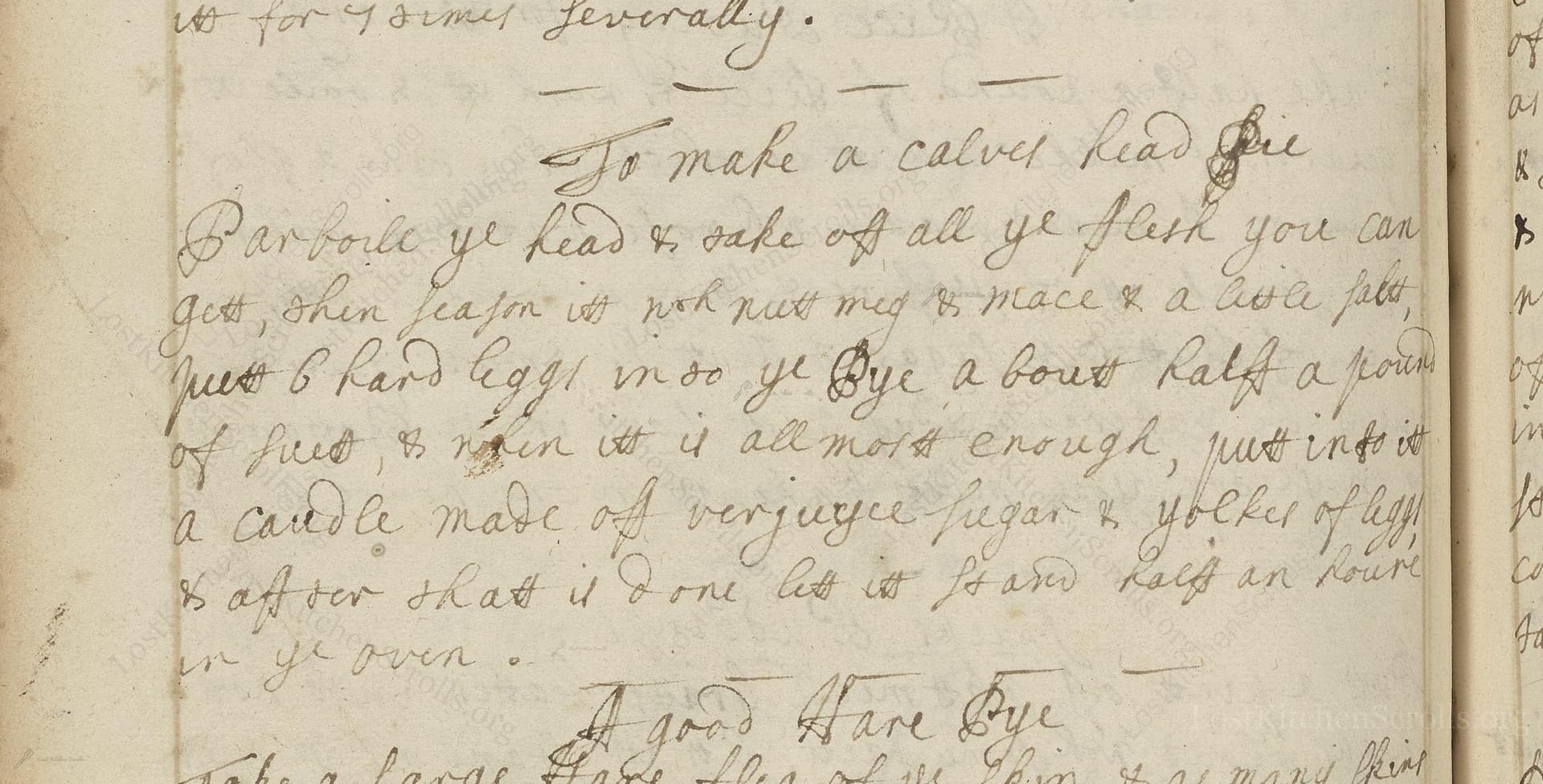To Make A Calves Head Pie
From the treasured pages of Receipt book of Mary Hookes
Written by Mary Hookes

To Make A Calves Head Pie
"Parboile ye head & take of all ye flesh you can gett, then season itt wth nut meg & mace & a litle salt, putt 6 hard eggs into ye Pye about half a pound of suet & when itt is all most enough, putt into itt a litle verjuyce sugar & yolkes of eggs & after that is done lett itt stand half an houre in ye oven."
Note on the Original Text
Like many handwritten recipes of the late 17th century, the instructions are brief, assuming a high degree of kitchen experience. Words are spelled phonetically ('ye' for 'the', 'itt' for 'it') and ingredients are measured by approximation or household custom. Directions often omit steps considered obvious at the time, leaving much to the cook’s judgment and local tradition.

Title
Receipt book of Mary Hookes (1700)
You can also click the book image above to peruse the original tome
Writer
Mary Hookes
Era
1700
Publisher
Unknown
Background
A delightful voyage into the kitchens of the late 17th and early 18th centuries, this book teems with forgotten flavors, aromatic recipes, and the elegant wisdom of early modern cookery. A treasure trove for culinary adventurers craving a taste of the past!
Kindly made available by
Folger Shakespeare Library
This dish originates from the late 17th to early 18th century, a time when every part of the animal was valued and elaborate pies graced the English table, especially at holidays and feasts. Mary Hookes, an Englishwoman active around 1680, penned this recipe, most likely for wealthy households with access to specialty butchers and ample kitchen help. Such pies showcased not only culinary skill but also economic thrift and hospitality, making use of richly flavored offal and combining sweet, savory, and tangy elements typical of the era’s complex palate.

The cook would have used a large cauldron or pot to parboil the calf's head over an open flame or hearth. A sharp knife was essential for removing and chopping the flesh. A heavy wooden board and pestle and mortar might be used for seasoning and mincing suet. For baking, a deep earthenware or metal pie dish would be lined and filled, then baked in a wood-fired brick oven. A whisk or wooden spoon would combine the verjuice, sugar, and egg yolks for the final topping.
Prep Time
45 mins
Cook Time
1 hr 15 mins
Servings
8
We've done our best to adapt this historical recipe for modern kitchens, but some details may still need refinement. We warmly welcome feedback from fellow cooks and culinary historians — your insights support the entire community!
Ingredients
- 1 calf's head (approximately 4½–5½ lb, cleaned and split; substitute with 2¼ lb beef cheeks and 2¼ lb veal or beef shin, if unavailable)
- 1/2 teaspoon ground nutmeg
- 1/2 teaspoon ground mace
- 1/2 teaspoon salt (plus more to taste)
- 6 eggs (hard-boiled and quartered)
- 8 oz beef suet (shredded; substitute with 7 oz cold grated butter for suet-free option)
- 2 tablespoons verjuice (substitute: 2 tablespoons dry white wine mixed with 1 teaspoon lemon juice)
- 2 teaspoons sugar
- 2 egg yolks (for sauce)
- Shortcrust pastry (about 18 oz, enough for base and lid)
Instructions
- Begin by parboiling one calf's head (ask your butcher to clean and split it).
- Once parboiled, carefully remove all the flesh from the bones and chop it into bite-sized pieces.
- Season the meat generously with 1/2 teaspoon ground nutmeg, 1/2 teaspoon ground mace, and 1/2 teaspoon salt.
- Prepare six hard-boiled eggs, peeling and quartering them.
- Take about 8 ounces of beef suet, shredded or finely chopped, and mix it through the seasoned meat.
- Line a deep pie dish with shortcrust pastry, fill it with the seasoned meat, eggs, and suet, then cover with a pastry lid.
- Bake in a preheated oven at 350°F.
- When the pie is almost fully cooked (about 45 minutes for a medium pie), beat together 2 tablespoons of verjuice or substitute with 2 tablespoons of white wine mixed with a squeeze of lemon, 2 teaspoons sugar, and the yolks of 2 eggs.
- Pour this mixture into a small hole in the pie lid, then return to the oven for another 30 minutes until set and golden.
Estimated Calories
600 per serving
Cooking Estimates
It takes some time to prepare and parboil the meat, then assemble the pie and bake it. Most of the time is hands-off while the pie is cooking. One slice is a generous serving, and the calories are an estimate for each piece.
As noted above, we have made our best effort to translate and adapt this historical recipe for modern kitchens, taking into account ingredients nowadays, cooking techniques, measurements, and so on. However, historical recipes often contain assumptions that require interpretation.
We'd love for anyone to help improve these adaptations. Community contributions are highly welcome. If you have suggestions, corrections, or cooking tips based on your experience with this recipe, please share them below.
Join the Discussion
Rate This Recipe
Dietary Preference
Main Ingredients
Occasions

Den Bockfisch In Einer Fleisch Suppen Zu Kochen
This recipe hails from a German manuscript cookbook compiled in 1696, a time whe...

Die Grieß Nudlen Zumachen
This recipe comes from a rather mysterious manuscript cookbook, penned anonymous...

Ein Boudain
This recipe comes from an anonymous German-language manuscript cookbook from 169...

Ein Gesaltzen Citroni
This recipe, dating from 1696, comes from an extensive anonymous German cookbook...
Browse our complete collection of time-honored recipes



